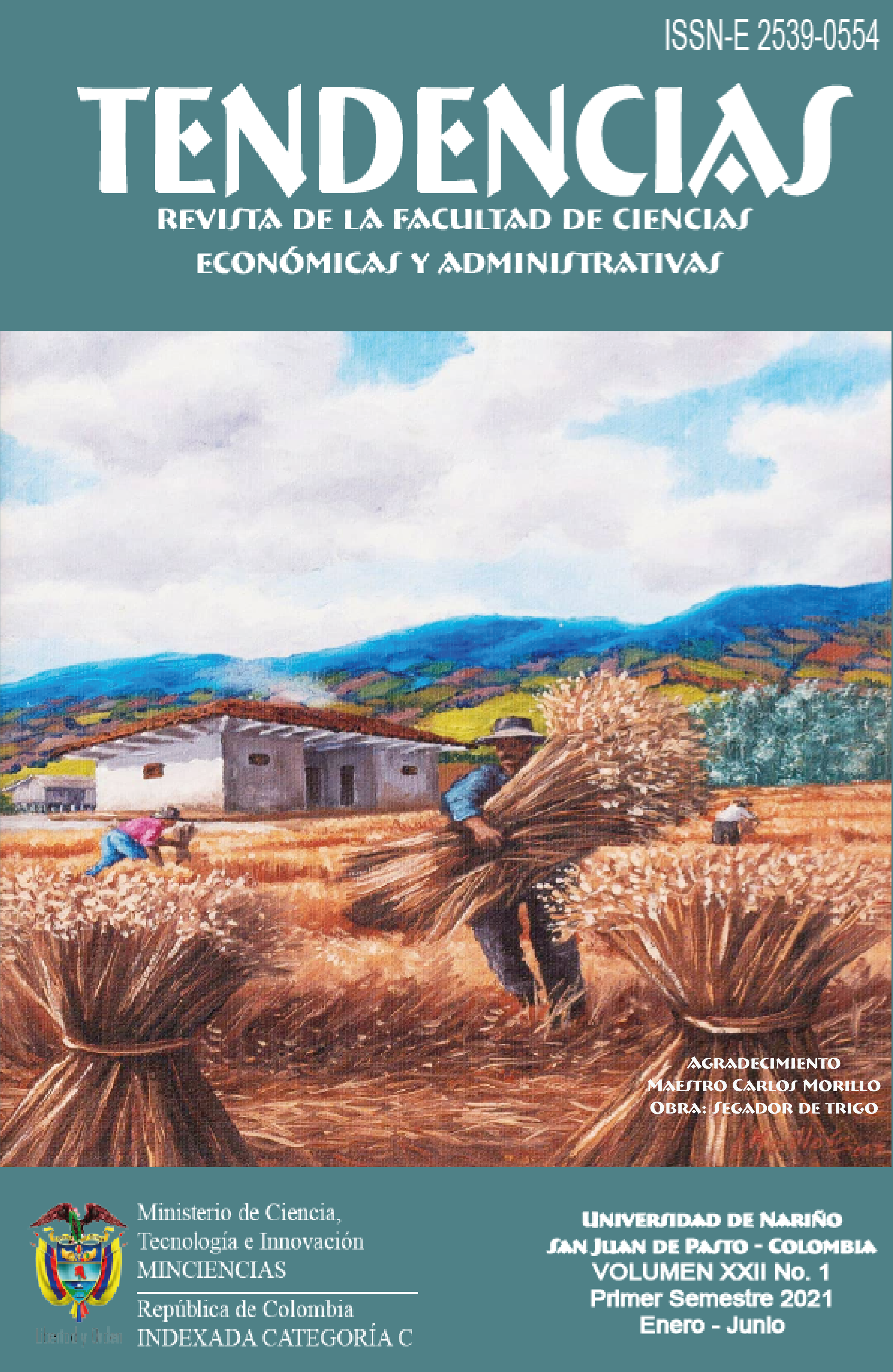Analysis of venezuelan migration in the city of Pasto: characteristics and perceptions of migrants
DOI:
https://doi.org/10.22267/rtend.202102.155Keywords:
sociodemographic characteristics, determinants of migration, venezuelan economy, international migration, VenezuelaAbstract
The study aims to analyze Venezuelan migration in the city of Pasto. The theoretical support analyzed the main theories that conform the economic approach of international migrations. The methodological design included the construction of a survey for the sociodemographic characterization of the population and the definition of their perceptions regarding the determinants that led them to take the decision of migrating. Among the conclusions of the study, it is highlighted that the population of Venezuelans in the city of Pasto is a significantly young group, settled in the commercial centers of the city and most of them do not come from regions near the Colombian-Venezuelan border. The jobs that most of this population in the city of Pasto is linked to are informal, mainly as street vendors and that allows them to send remittances to Venezuela. As for the determinants of the decision to migrate, according to the perception of those consulted, the greatest influence was exerted by economic factors such as inflation and food shortages in Venezuela, but other variables such as insecurity, poverty and discontent with the current government of that country also stood out.
Downloads
References
(1) Álvarez, R. (2004). La dinámica migratoria colombo-venezolana: evolución y perspectiva actual. Geoenseñanza, 9(2), 191-202. https://www.redalyc.org/pdf/360/36090205.pdf
(2) Arango, J. (2003). La explicación teórica de las migraciones: luz y sombra. Migración y Desarrollo, 1, 1-30. https://www.redalyc.org/articulo.oa?id=66000102
(3) Asamblea Nacional de Venezuela. (2020). Índice Nacional de Precios de la Asamblea Nacional (INPCAN). https://angelalvaradorangel.com/wp-content/uploads/Inflaci%C3%B2n-Asamblea-Nacional-mes-de-Marzo-2020.pdf
(4) Banco Mundial. (2018). Migración desde Venezuela a Colombia: impactos y estrategia de respuesta en el corto y mediano plazo. https://r4v.info/es/documents/download/66643
(5) Banco Mundial. (2019). Más allá de las fronteras: una mirada al éxodo venezolano.
(6) Castillo, T. y Reguant, M. (2017). Percepciones sobre la migración venezolana: causas, España como destino, Expectativas de retorno. Migraciones, (41), 133-163. https://doi.org/10.14422/mig.i41.y2017.006
(7) Castles, S. (2014). Las fuerzas tras la migración global. Revista Mexicana de Ciencias Políticas y Sociales, 59(220), 235-260.
(8) Comisión Económica para América Latina y el Caribe [CEPAL]. (2019a). Panorama social de América Latina. Publicaciones CEPAL. https://www.cepal.org/es/publicaciones/44969-panorama-social-america-latina-2019
(9) Comisión Económica para América Latina y el Caribe [CEPAL]. (2019b). Balance Preliminar de las Economías de América Latina y el Caribe 2019. Santiago: Cepal. https://repositorio.cepal.org/bitstream/handle/11362/45000/91/BPE2019_Venezuela_es.pdf
(10) Echeverry, A. (2011). Análisis de la migración venezolana a Colombia durante el gobierno de Hugo Chávez (1999-2011). Identificación de capital social y compensación económica. Revista Análisis Internacional (Cesada a partir de 2015), 1(4), 33-52. https://revistas.utadeo.edu.co/index.php/RAI/article/view/84
(11) España, L. y Ponce, M. (2018). Encuesta sobre Condiciones de Vida en Venezuela. https://www.ucab.edu.ve/wp-content/uploads/sites/2/2018/02/ENCOVI-2017-presentaci%C3%B3n-para-difundir-.pdf
(12) Freitez, A. (2011). La emigración desde Venezuela durante la última década. Revista temas de coyuntura, 63, 11-38.
(13) García, M. y Restrepo, J. (2019). Aproximación al proceso migratorio venezolano en el siglo XXI. Hallazgos, 16(32), 63-82. http://dx.doi.org/10.15332/2422409x.5000
(14) Gómez, J. (2010). La migración internacional: teorías y enfoques. Semestre Económico, 13(26), 81-99.
(15) Izcara, S. (2009). Privación relativa y emigración: El caso Tamaulipeco. Migraciones internacionales, 5(1), 7-33. http://www.scielo.org.mx/pdf/migra/v5n1/v5n1a1.pdf
(16) Lomelí, L. y Vázquez, L. (2016). Cambio estructural y migración. El caso de México. Economía UNAM, 13(39), 3-25. https://doi.org/10.1016/j.eunam.2016.08.001
(17) Martinez, U. (2000). Teorías sobre las migraciones. Migraciones y exilios, (1), 11-26. https://dialnet.unirioja.es/servlet/articulo?codigo=2328060
(18) Massey, D., Arango, J., Graeme, H., Kouaouci, A., Pellegrino, A., & Taylor, E. (1993). Theories of International Migration: A Review and Appraisal. Population and Development Review, 19(3), 431-466. https://doi.org/10.2307/2938462
(19) Mejía, W. (2012). Colombia y las migraciones internacionales: evolución reciente y panorama actual a partir de las cifras. Revista Interdisciplinar da Mobilidad Humana, 20(39), 185-210. https://www.scielo.br/pdf/remhu/v20n39/v20n39a10
(20) Navarro, J. y Moyano, E. (2017). Metodología, temas y disciplinas en la investigación actual sobre migración internacional. Societade e Cultura, 20(2), 138-153. https://doi.org/10.5216/sec.v20i1.53069
(21) Novelo, F. (2008). Economía y migración. Universidades, (39), 29-44. http://www.redalyc.org/articulo.oa?id=37312911004
(22) Observatorio venezolano de violencia. (2020). Informe Anual de Violencia 2019.
https://observatoriodeviolencia.org.ve/news/informe-anual-de-violencia-2019/
(23) Organización Internacional para las Migraciones [OIM]. (2006). Glosario sobre migración. https://publications.iom.int/system/files/pdf/iml_7_sp.pdf
(24) Programa Mundial de Alimentos [PMA]. (2020). Evaluación de seguridad alimentaria en Venezuela. https://reliefweb.int/sites/reliefweb.int/files/resources/WFP_VEN_FSA_Main%20Findings_2020_espanol_final.pdf
(25) Response for Venezuelans [R4V]. (2019). Latin Amaerica and the Caribbean Venezuelan Refugees & Migrants in the region. https://data2.unhcr.org/en/documents/download/69837
(26) Requena, J. y Caputo, C. (2016). Pérdida de talento en Venezuela: migración de sus investigadores. Interciencia, 41(7), 444-453. https://www.redalyc.org/pdf/339/33946267002.pdf
(27) Servicio Jesuita a Refugiados Venezuela [JRS Venezuela]. (2019). Informe de movilidad humana venezolana II: Realidades y perspectivas de quienes emigran. https://jesuitas.lat/attachments/article/1450/Informe%20Movilidad%20Humana%20Venezolana%20Julio%202019.pdf
(28) Simmons, A. (1991). Explicando la migración: la teoría en la encrucijada. Estudios Demográficos y Urbanos, 6(1), 5-31. https://www.jstor.org/stable/40368378
(29) Stark, O., & Bloom, D. (1985). AssociationThe New Economics of Labor Migration. The American Economic Review, 75(2), 173-178.
(30) TResearch. (2019). Consulta Mitofsky: crisis en Venezuela ¿a quién apoyan los venezolanos? https://drive.google.com/file/d/1NHFH4aen7f9ytmVQOrAODwWiM1CaHi2G/view
Published
How to Cite
Issue
Section
License
Those authors who have publications with this journal, accept the following terms:
This journal is licensed under a Creative Commons Reconocimiento-NoComercial 4.0 Internacional License. The articles can be copied, distributed, adapted and communicated publicly, as long as the credits of the work are recognized and the respective source is quoted. This work can not be used for commercial purposes.
To increase their visibility, documents are sent to databases and indexing systems.
The content of the items is the responsibility of each author, and does not compromise in any way, journal or institution.







































